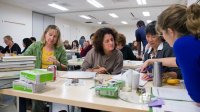Exhibits and Education Are Integrated at the California Academy of Sciences
The world’s greenest museum inspires the next generation of scientists.
Your content has been saved!
Go to My Saved Content.Very early in the morning one fall weekend in San Francisco's Golden Gate Park, the new California Academy of Sciences building already hums with life hours before its doors open to the public.
It's been nearly ten years in the making, with four years in a cramped, temporary facility, and the newly designed museum's transparent five-story glass walls turn incandescent in the glow of the rising sun. Butterflies and insects hover and dart over a hill-like rooftop blanketed with living wildflowers and strawberry plants. The day's troop of volunteer docents, brightly visible in orange T-shirts, begin to arrive at the staff entrance.
Inside, animal-care specialists carry birdseed and plates of freshly cut oranges into the 90-foot-diameter glass-domed rain forest. Nearby, far above a living reproduction of a Philippine coral reef, metal-halide heat lamps click on in a simulated sunrise. In the swamp exhibit, one floor below the lobby, an albino alligator named Claude turns his head in slow motion. The long-anticipated new venue is ready for its close-up.
A security guard directs a group of elementary school teachers to a third-floor workshop, Energy Issues in a Changing World. When a crowd of people, a flotilla of baby strollers among them, are allowed to enter the front door, a young boy dashes toward the West Hall, where the skeleton of an 87-foot blue whale hangs suspended from the ceiling. "Bones!" he shouts over his shoulder to his lagging parents. "Who wants to come see some bones?"
An Institution Shaken and Stirred
Founded in 1853, the California Academy of Sciences is the country's oldest scientific institution in the West. Over the decades, it has fallen, risen, expanded, and fallen again.
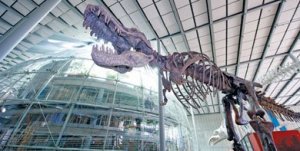
Originally located in what is now downtown San Francisco, it was destroyed in the fiery aftermath of the 1906 earthquake. Rebuilt and relocated to Golden Gate Park, the Academy grew in size, adding what's now called the Kimball Natural History Museum in 1916, the Steinhart Aquarium in 1923, and the Morrison Planetarium in 1952. With the expansions, the museum became a center for natural science research and a prime source for educational-outreach programs.
The cause of its most recent, most dramatic reincarnation was the 1989 Loma Prieta earthquake, which shook the Bay Area and damaged the Academy so severely that a complete seismic retrofit was required. Instead, the decision was made to raze the buildings and start from the ground up.
Like other great science institutions -- New York City's American Museum of Natural History and the Smithsonian Institution's National Museum of Natural History, in Washington, DC, for instance -- the Academy logically might have focused on galleries and displays showcasing portions of its 20-million-specimen collection, a cornucopia ranging from giant Galapagos tortoise shells to Maasai tribal shields to tyrannosaur fossil bones.
After all, the traditional role of natural history museums has been to study, catalog, and present diversity. Senior Scientist John McCosker, chair of the Department of Aquatic Biology, points out that the nation's oldest natural science museum -- Philadelphia's Academy of Natural Sciences -- has a substantial collection of animal fossils and plants.
But former executive director Patrick Kociolek and his board of trustees saw in the loss of the existing buildings an opportunity, as current executive director Gregory Farrington explains, "to create a museum of the 21st century" that would highlight "two of the most important issues of our time: evolution and sustainability. First, how did life on Earth develop? Second, how will we find a way to stay?"
Using a radically different design by world-renowned architect Renzo Piano, winner of the Pritzker Architecture Prize, as an inspiration, the Academy weaves the answers to Farrington's questions throughout the new exhibits and even within the building's walls. Solar panels ring the exterior. Hidden tubes carrying heated water warm the concrete floor. Recycled denim insulates the walls. The soil- and plant-covered living rooftop keeps the building about 10 degrees cooler on hot days than a standard roof.
A majority of the material from the demolished structure was recycled, while the bulk of the new steel and half of the concrete also came from recycled sources. Not long after its opening last autumn, the Academy earned the U.S. Green Building Council's highest platinum-level Leadership in Energy and Environmental Design certification.
Nature Nurtured
"We've broken the barriers," says McCosker in his basement-level office. "We no longer have 12 individual halls of stuff. Instead, the single building itself is an exhibit. You can see water and fish from every floor. I like to say that the aquarium has finally leaked into the rest of the museum."
"Given our mission, we have to walk the walk," says Meg Burke, director of education. "That's why we have this phenomenally green building. But our director, Greg, makes the point that the building is like a marvelous stage. Now the emphasis must shift to the play -- what stories are we presenting on this stage?"
According to Burke, who heads the museum's 12-person educational department, the new Academy has integrated its exhibits with its research and education divisions. Video screens are next to dioramas in the African Hall, detailing the field research on species conservation next to scenes of predators and prey in their native habitat. The extensive fossil collection is no longer separated in its own hall but appears throughout an exhibit called Altered State: Climate Change in California as a telling reminder of previous species' extinctions.
"You can't help California's teachers if you aren't paying attention to science-content teaching standards," says Burke. The exhibition's designers were guided by the feedback from an extensive study that examined how an exhibit's main theme could serve a general audience as well as different class levels. As a result, she says, "our exhibits tell stories."
One reason the Academy recreated a Philippine coral reef exhibit rather than a Caribbean or Indian Ocean coral reef, according to Burke, is that "we have a positive story to highlight. There is a wonderful, citizen-led, grassroots conservation effort taking place in the Philippines, as well as government legislation to protect this endangered habitat."
Carol Tang, director of visitor interpretive programs, works a few glass-walled offices away from Burke. Her department, she says, thinks extensively about how to present a conservation message to very young visitors.
"Research shows that even at the kindergarten through third-grade level, kids can grasp sophisticated science ideas," she says. "By age seven or eight, students have a great sense of justice. They understand when things are unfair, and they want to do something about it. And they can also get their parents to act, which is why you see so much recycling in schools."
The Academy builds on this interest with exhibits that ask visiting students to measure the carbon footprint of different meal choices or that illustrate current conservation activities and prompt kids to write down what changes in their own lives might help.
"We don't want to replicate the classroom, and we're not going to pretend that every student is going to read every exhibit label," says Tang. "But we hold weekend workshops for elementary school teachers to prepare them for field trips, to review the science and learn more about each exhibit.
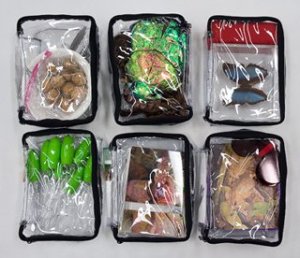
We can send them actual science kits plus online resources and lesson plans to use in the classroom before and after a class visit. We can provide targeted activities like scavenger hunts for predator and prey in the Africa Hall dioramas."
An exhibit like Climate Change can satisfy a high school standard, she says, while an elementary school teacher can meet those standards by focusing on the intricacies of the local ecosystem.
Staff members in Burke's education division seem acutely aware of California public school test scores. A study from staff at the University of California at Berkeley's Lawrence Hall of Science, in association with the nonprofit research and development agency WestEd, uncovered possible reasons for California's low national standing on fourth- and eighth-grade science achievement. One cause is that K-5 teachers with several subjects to present have limited time for science.
Another theory is that California's elementary school teachers feel less well prepared and well qualified to teach science than any other subject and believe they have few opportunities to improve their preparation.
"So, we're giving them the tools," says Tang, "and we're giving them the cool factor."
Burke adds, "We literally want to make their jaws drop. Because when the students have one of those 'Oh, wow!' moments, they're primed to learn."
A 2001 survey from the American Association of Museums found that Americans do, in fact, trust the hands-on, object-oriented educational content of museums above all other sources of information, including books, television, newspapers, radio, magazines, and the Internet. Why?
"We've got the real stuff," says Burke. "We are all about authenticity. And if we want to promote sustainability, if we want to find new ways to connect people to the natural world, to increase science literacy and environmental stewardship, it's essential that we reach out to train teachers."
Science and Generation Next
The Academy's multiyear Careers in Science (CIS) internship programs, launched in 1996, have so far brought 144 Bay Area public high school students into collaborations with Academy scientists. As program manager Eric Godoy says, students apply during the spring session of their sophomore year and, if accepted, start in June. Beginning interns are paid $10 per hour (with partial funding from a San Francisco city agency), and have the option of applying for higher levels of responsibility and earning higher pay.
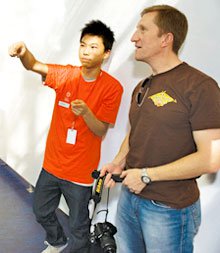
Interns can continue until they're 21 before they "age out." Thirty-five students -- 20 in high school and 15 in college -- are participating in CIS this year. The interns work as museum interpreters on the weekends, answering the public's many questions at such popular exhibits as the penguin tank.
"On weekdays, they learn science in workshops, collaborative groups, and training seminars," says Godoy. "It's peer-to-peer training, where they have to learn and teach to each other." The interns also participate in special workshops and field trips, where they receive specialized instruction from professionals such as Academy scientists.
At 4 p.m. on weekdays, CIS interns arrive at their cubicles on the Academy's third floor. The view from their computer stations through glass walls takes in a commanding vista of Golden Gate Park's gnarled cypress trees and Monterey pines.
Kylie Wong, a junior at San Francisco's Lowell High School, pulls up a Microsoft Excel spreadsheet on her computer, an annotated list of photographs of more than 90 plants that Frank Almeda, chair and senior curator of the Department of Botany, has found growing on the living roof. Wong is cataloging the Latin and common names of each plant.
"When they planted the roof, they purposely started with only 9 native plants," she says. "Some of the rest came from birds or the park or wind and stuff." Wong, who joined the program last summer, is looking forward to working with Almeda on a special research project. "We're going to catalog all the new species and clear a new plot, and take pictures and samples and see what grows there," she says.
Fellow intern Michelle Kern is a first-year City College of San Francisco student who speaks with an easy confidence about having helped the museum's Department of Ornithology and Mammalogy unpack many of its specimens that had been moved from the temporary location on Howard Street to the new facility in Golden Gate Park.
"They just have so much in the collection," Kern says. "All the skulls in boxes, the eggs and nests and bird-study skins on trays, even the polar bear and other mammal pelts, we had to organize and pack."
Collections manager Maureen Flannery was grateful for the interns' help. "That was not a fun job," she recalls. "Those pelts were old, heavy, and dusty. Plus, at 50 degrees, it was very cold. But they came in every week, and they seemed to have fun. We couldn't have completed our move without them."
Every summer, Flannery gives the new interns a tour of the museum's collections, which staff scientists use to study the relationships between organisms. In storage units at the new Academy are 20 million specimens, including more than 100,000 birds, 30,000 mammals, and 10,000 nests and eggs, plus tissue collections for DNA research.
Lesley Sanders, a recent graduate of San Francisco's Abraham Lincoln High School who attends Los Medanos College, in Pittsburg, California, recalls how she heard about the program. "My cousin worked here. She used to come home, and we'd see something on TV or a flyover, and she'd say, 'Did you know owls have two stomachs?' I'd say, 'Where are you getting all this information from?'
"Finally, when I turned 14, she encouraged me to get involved. By then, she was feeding the alligator gars and working with the other fish, so that was the reason I really pushed for it."
Penguins, Pupils, and the Public
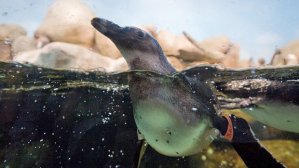
These days, Sanders's favorite activity is teaching on the public floor. "At the temporary exhibit on Howard Street, I did a lot of the penguin explaining," she says. "That was my favorite station. A crowd of people would come up, and I'd give the whole lowdown: where they're from, how much they weigh, how much they swim, when they mate, how many eggs they lay. So any question they asked, I had it covered."
During the summer, the CIS interns focus on field research. "My favorite research was taking field notes down at Ocean Beach," says Rashim Khadka, a new intern from San Francisco's Galileo High School.
He pulled out a three-ring binder still sandy from weekly trips several months before. "We caught sand crabs and measured them, dissected them," he says. "We took notes and drew pictures, basically the same thing the professionals do."
Jack Dumbacher, chairman of and assistant curator in the Department of Ornithology and Mammalogy, is gratified to hear that the interns enjoyed taking field notes.
"This is the heart of how to get people excited about science," says Dumbacher, who has led expeditions to the Namibian desert and Papua New Guinea. "It comes from honing your skills at observation."
All too often, he says, "science is taught as a series of biological facts that one must memorize. That's not what science is -- that's the product of science. Science is the art of investigation, learning new things about something we know nothing about.
"How do you create a body of knowledge?" Dumbacher adds. "By taking really good field notes. It makes you think about what you see. It makes you go back and discover things you wouldn't have noticed before. It helps you form questions. And that's how you start to think like a scientist."
Next summer, if Academy scientists receive a contract from the Presidio Trust, the agency that oversees the nearby Presidio park, formerly a military base, interns will help Dumbacher and Flannery make an inventory of the small mammals living in the park.
"They've all been very excited to figure out how you discover what's out there, what habitats you explore," says Flannery. "Right now, they're helping me develop research protocols."
Flannery, who can work with fellow scientists, doctoral candidates, or advanced graduate students on any research project, takes a moment to think about the benefits of working with the high school interns.
"At first, I was not convinced I had time for this project," he says. "But when Eric and I spoke about getting the interns involved, I realized it would be worth it. They inspire me. I hope I inspire them, too."
Reaching into the Classroom
The California Academy of Sciences offers its own standards-based classroom kits that are mailed to local K-8 schools. Teachers select kits based on a subject, such as rain forests or predator-prey relations.
Kits arrive with specimens, activities, and lesson plans, which teachers can use to prepare their classes for upcoming field trips and also to translate state-mandated science curricula and concepts into engaging project-based activities. Read more about the Academy's education programs.
